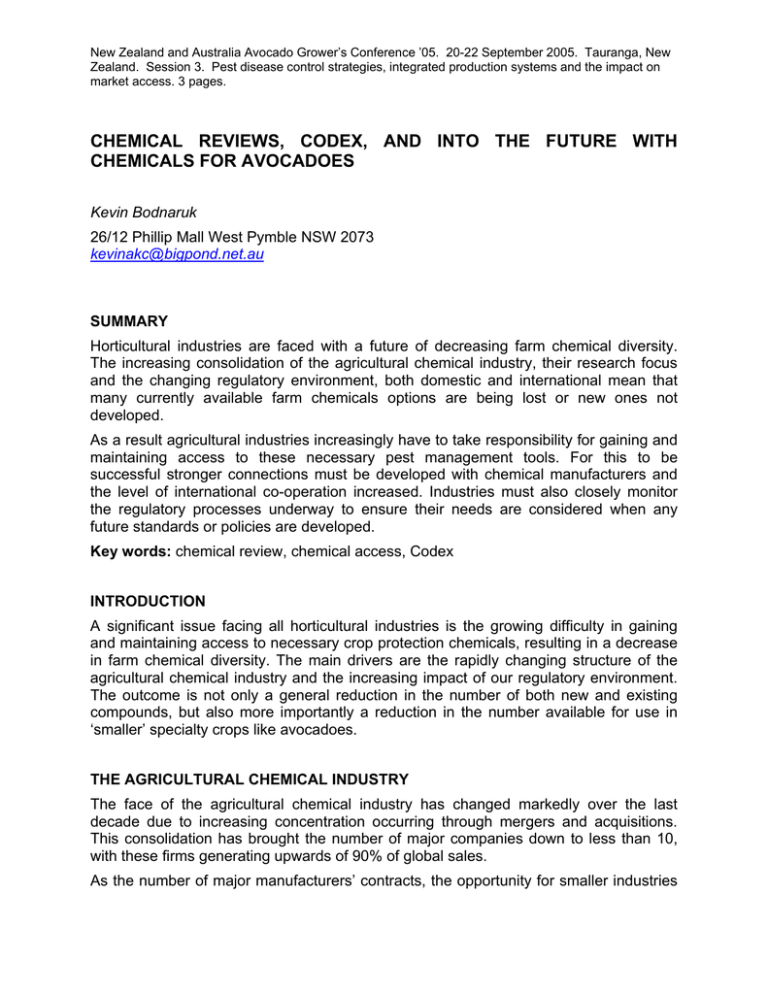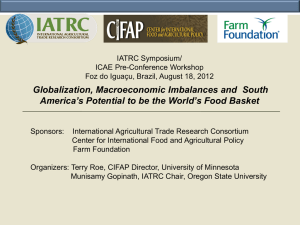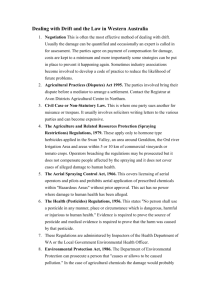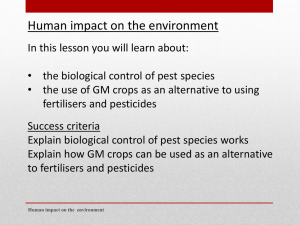New Zealand and Australia Avocado Grower’s Conference ’05. 20-22... Zealand. Session 3. Pest disease control strategies, integrated...
advertisement

New Zealand and Australia Avocado Grower’s Conference ’05. 20-22 September 2005. Tauranga, New Zealand. Session 3. Pest disease control strategies, integrated production systems and the impact on market access. 3 pages. CHEMICAL REVIEWS, CODEX, AND INTO THE FUTURE WITH CHEMICALS FOR AVOCADOES Kevin Bodnaruk 26/12 Phillip Mall West Pymble NSW 2073 kevinakc@bigpond.net.au SUMMARY Horticultural industries are faced with a future of decreasing farm chemical diversity. The increasing consolidation of the agricultural chemical industry, their research focus and the changing regulatory environment, both domestic and international mean that many currently available farm chemicals options are being lost or new ones not developed. As a result agricultural industries increasingly have to take responsibility for gaining and maintaining access to these necessary pest management tools. For this to be successful stronger connections must be developed with chemical manufacturers and the level of international co-operation increased. Industries must also closely monitor the regulatory processes underway to ensure their needs are considered when any future standards or policies are developed. Key words: chemical review, chemical access, Codex INTRODUCTION A significant issue facing all horticultural industries is the growing difficulty in gaining and maintaining access to necessary crop protection chemicals, resulting in a decrease in farm chemical diversity. The main drivers are the rapidly changing structure of the agricultural chemical industry and the increasing impact of our regulatory environment. The outcome is not only a general reduction in the number of both new and existing compounds, but also more importantly a reduction in the number available for use in ‘smaller’ specialty crops like avocadoes. THE AGRICULTURAL CHEMICAL INDUSTRY The face of the agricultural chemical industry has changed markedly over the last decade due to increasing concentration occurring through mergers and acquisitions. This consolidation has brought the number of major companies down to less than 10, with these firms generating upwards of 90% of global sales. As the number of major manufacturers’ contracts, the opportunity for smaller industries to gain or maintain access to compounds diminishes correspondingly. . With Australia and New Zealand comprising less than 2% of the total world market for agricultural chemicals, the needs of our rural industries assume lesser priority. Australasian horticultural crops and pests seldom figure prominently in the considerations of agricultural chemical multinationals. This means that local growers must suffer loss of access, either through withdrawn support or research priorities being focused upon northern hemisphere issues. Consequently fewer resources are available to develop products for ‘smaller’ local agricultural industries. Withdrawal of support can manifest either through compounds or uses not receiving company endorsement at the regulatory level; or being discontinued following the rationalisation of newly merged company product portfolios. The increasing costs associated with testing chemicals, together with increasing regulatory requirements, are often blamed. This is often the case where a product is out of patent and has become particularly acute due to the impact of chemical reviews. Past experience has shown that a company’s decision to support a chemical is invariably based on its uses in major crops. For instance, where research priorities are concerned the overarching consideration for manufacturers are crops of global significance such as cereals, cotton, soybeans and rice, and the major pests in those crops. Unfortunately, since few horticultural crops come close to making these lists, many uses for smaller crops are simply dropped from labels or not pursued thereby reducing pest management options for those minor crops. In effect, smaller agricultural industries are forced to compete for company research and development resources. At the country level this can become particularly acute. REGULATORY ENVIRONMENT Chemical industry regulation is becoming increasingly internationalized through harmonization between countries and the significance of Codex standards to global food trade. The regulatory environment has significant impact on what might be available for use. In this context it can be broadly divided, into two elements in terms of trade: risk assessment; and enforcement. Risk assessment of farm chemicals can greatly restrict farm chemical availability. Increasing demands for safety and the resulting risk assessment methodologies mean that regulators are reassessing older compounds against current standards. Manufacturers are responding by shedding the older generic compounds, since for them it is not worthwhile carrying out the testing required to meet new standards to maintain uses. This pattern is being repeated both in Australia and at various regulatory fora such as Codex, the United Nations food standards setting body, and the EU. In Australia the APVMA has an ongoing review of farm chemicals with 28 reviews currently underway. The majority of these have significant uses in horticultural crops, yet few are likely to receive support from companies. In Europe over 300 farm chemicals were lost in 2003, and if this trend continues, the number of farm chemicals available in Europe could fall by over 60% within the next few years. Such a loss of chemical diversity will almost certainly increase pressure on agricultural production in two ways: • by increasing the risk of pests developing resistance to available chemicals, with the consequent adverse effect on pest and disease control; • by bringing greater pressure to bear on smaller specialty growers by reducing the pest management options available. From a trade and enforcement perspective food quality and safety is the focus. However, signs are emerging that food-importing countries are using the standards as potential trade barriers, particularly as the current science based approach to regulation is challenged. Increasingly issues relating to compliance with domestic maximum residue limits (MRLs) are being raised, potentially disadvantaging exporters. At the international level Codex has a number of committees actively developing a range of standards covering such issues as fruit and vegetable quality standards, labelling, food hygiene and contaminants. These are particularly important since they are implicitly accepted by many countries. The World Trade Organisation (WTO) also uses them as benchmarks in any dispute resolution process. The activity of these committees is of particular interest due to concerns over the potential for ‘regulatory capture’ to occur, i.e., where the standards being proposed benefit the promoter of the standard rather than consumers per se. THE FUTURE As it is unlikely that the situation will change markedly in the foreseeable future farming industries need to consider how they will respond to these increasingly complex issues. As outlined above the regulatory and farm chemical environment, within which Australia and New Zealand operate is subject to continual change. This calls for a proactive approach by horticultural industries to bring about change. They must decide how they are going to: • respond to the challenges posed by chemical reviews, • gain access to newer chemistry, • influence the processes for establishing international standards. To achieve this individual industries must take greater responsibility for gaining or maintaining access to the relevant farm chemicals. Ways of achieving this include: building and maintaining relationships with manufacturers; increasing the level of international co-operation on data generation and sharing for needed pest management tools; participating more fully in the regulatory processes to ensure their needs are considered in the development of future standards or policies.




